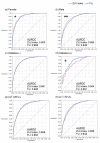Prediction of Nonalcoholic Fatty Liver Disease Using Noninvasive and Non-Imaging Procedures in Japanese Health Checkup Examinees
- PMID: 33467114
- PMCID: PMC7830542
- DOI: 10.3390/diagnostics11010132
Prediction of Nonalcoholic Fatty Liver Disease Using Noninvasive and Non-Imaging Procedures in Japanese Health Checkup Examinees
Abstract
Access to imaging is limited for diagnosing nonalcoholic fatty liver disease (NAFLD) in general populations. This study evaluated the diagnostic performance of noninvasive and nonimaging indexes to predict NAFLD in the general Japanese population. Health checkup examinees without hepatitis virus infection or habitual alcohol drinking were included. Fatty liver was diagnosed by ultrasonography. The hepatic steatosis index (HSI), Zhejiang University (ZJU) index, and fatty liver index (FLI) were determined, and risk of advanced liver fibrosis was evaluated by the fibrosis-4 index. NAFLD was diagnosed in 1935 (28.0%) of the 6927 subjects. The area under the receiver operating characteristic (AUROC) curve of the HSI, ZJU index, and FLI was 0.874, 0.886, and 0.884, respectively. The AUROC of the ZJU index (p < 0.001) and FLI (p = 0.002) was significantly greater than that for the HSI. In subjects with a high risk of advanced fibrosis, the sensitivity of the HSI, ZJU index, and FLI were 88.8%, 94.4%, and 83.3% with a low cut-off value and the specificity was 98.5%, 100%, and 100% with a high cut-off value. In conclusion, all indexes were useful to diagnose NAFLD in the general Japanese population and in subjects with potentially advanced liver fibrosis.
Keywords: ROC; fatty liver index; fibrosis-4 index; health checkup; hepatic steatosis index; nonalcoholic fatty liver disease; ultrasonography.
Conflict of interest statement
The authors declare no conflict of interest.
Figures




Similar articles
-
Validation of fatty liver index and hepatic steatosis index for screening of non-alcoholic fatty liver disease in adults with obstructive sleep apnea hypopnea syndrome.Chin Med J (Engl). 2019 Nov 20;132(22):2670-2676. doi: 10.1097/CM9.0000000000000503. Chin Med J (Engl). 2019. PMID: 31765354 Free PMC article.
-
The performance of noninvasive indexes of adults in identification of nonalcoholic fatty liver disease in children.J Diabetes. 2021 Sep;13(9):744-753. doi: 10.1111/1753-0407.13169. Epub 2021 Mar 21. J Diabetes. 2021. PMID: 33576570
-
Comparative Assessment and External Validation of Hepatic Steatosis Formulae in a Community-Based Setting.J Clin Med. 2020 Sep 3;9(9):2851. doi: 10.3390/jcm9092851. J Clin Med. 2020. PMID: 32899243 Free PMC article.
-
Comparison of laboratory tests, ultrasound, or magnetic resonance elastography to detect fibrosis in patients with nonalcoholic fatty liver disease: A meta-analysis.Hepatology. 2017 Nov;66(5):1486-1501. doi: 10.1002/hep.29302. Epub 2017 Sep 26. Hepatology. 2017. PMID: 28586172 Review.
-
Comparison of FIB-4 index, NAFLD fibrosis score and BARD score for prediction of advanced fibrosis in adult patients with non-alcoholic fatty liver disease: A meta-analysis study.Hepatol Res. 2016 Aug;46(9):862-70. doi: 10.1111/hepr.12647. Epub 2016 Feb 16. Hepatol Res. 2016. PMID: 26763834 Review.
Cited by
-
Irisin Is Related to Non-Alcoholic Fatty Liver Disease (NAFLD).Biomedicines. 2022 Sep 11;10(9):2253. doi: 10.3390/biomedicines10092253. Biomedicines. 2022. PMID: 36140354 Free PMC article.
-
Comparison of hepatic steatosis index as noninvasive diagnostic tool and liver ultrasound for non-alcoholic steatosis in the adult population.Gastroenterol Hepatol Bed Bench. 2022;15(4):360-365. doi: 10.22037/ghfbb.v15i4.2480. Gastroenterol Hepatol Bed Bench. 2022. PMID: 36762218 Free PMC article.
-
CT-based Hounsfield unit values reflect the degree of steatohepatitis in patients with low-grade fatty liver disease.BMC Gastroenterol. 2023 Mar 17;23(1):77. doi: 10.1186/s12876-023-02717-3. BMC Gastroenterol. 2023. PMID: 36932382 Free PMC article.
-
Usefulness of health checkup-based indices in identifying metabolic dysfunction-associated steatotic liver disease.JGH Open. 2024 Jun 17;8(6):e13110. doi: 10.1002/jgh3.13110. eCollection 2024 Jun. JGH Open. 2024. PMID: 38895100 Free PMC article.
-
Diagnostic ability using fatty liver and metabolic markers for metabolic-associated fatty liver disease stratified by metabolic/glycemic abnormalities.J Diabetes Investig. 2023 Mar;14(3):463-478. doi: 10.1111/jdi.13966. Epub 2022 Dec 25. J Diabetes Investig. 2023. PMID: 36566480 Free PMC article.
References
-
- Vernon G., Baranova A., Younossi Z.M. Systematic review: The epidemiology and natural history of non-alcoholic fatty liver disease and non-alcoholic steatohepatitis in adults: Systematic review: Epidemiology of NAFLD and NASH. Aliment. Pharmacol. Ther. 2011;34:274–285. doi: 10.1111/j.1365-2036.2011.04724.x. - DOI - PubMed
-
- Hamaguchi M., Kojima T., Takeda N., Nakagawa T., Taniguchi H., Fujii K., Omatsu T., Nakajima T., Sarui H., Shimazaki M., et al. The Metabolic Syndrome as a Predictor of Nonalcoholic Fatty Liver Disease. Ann. Intern. Med. 2005;143:722–728. doi: 10.7326/0003-4819-143-10-200511150-00009. - DOI - PubMed
-
- Paul A. Nonalcoholic Fatty Liver Disease. N. Engl. J. Med. 2002;346:1221–1231. - PubMed
LinkOut - more resources
Full Text Sources
Other Literature Sources

